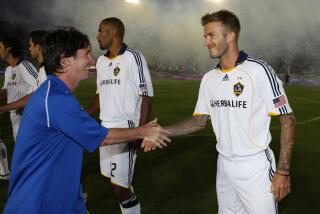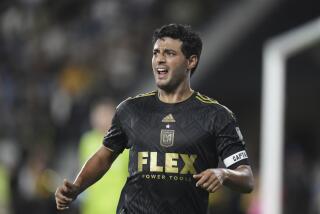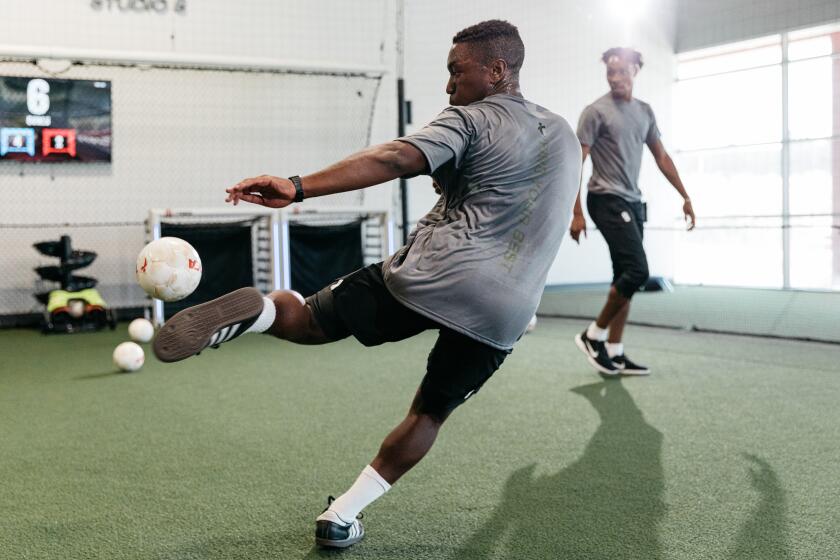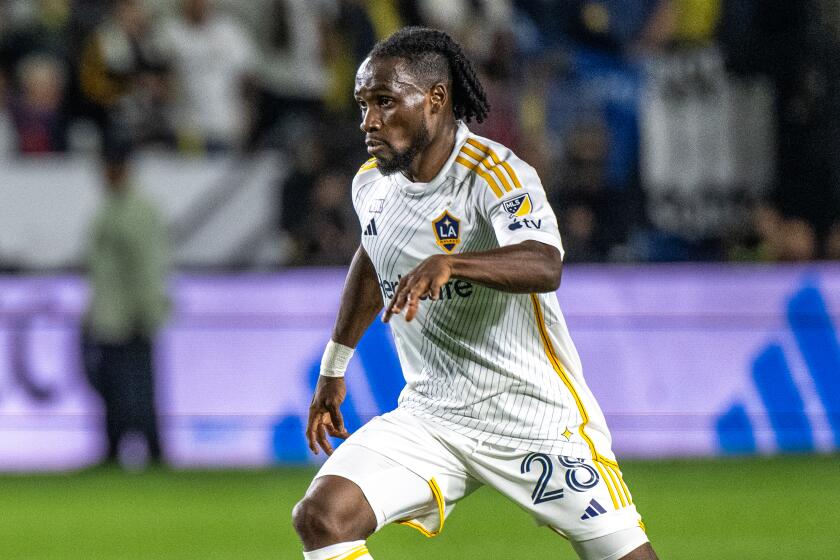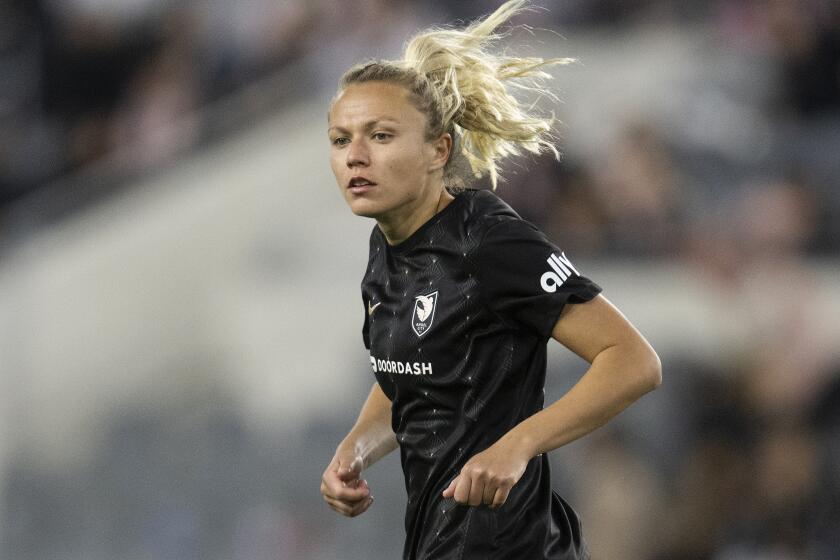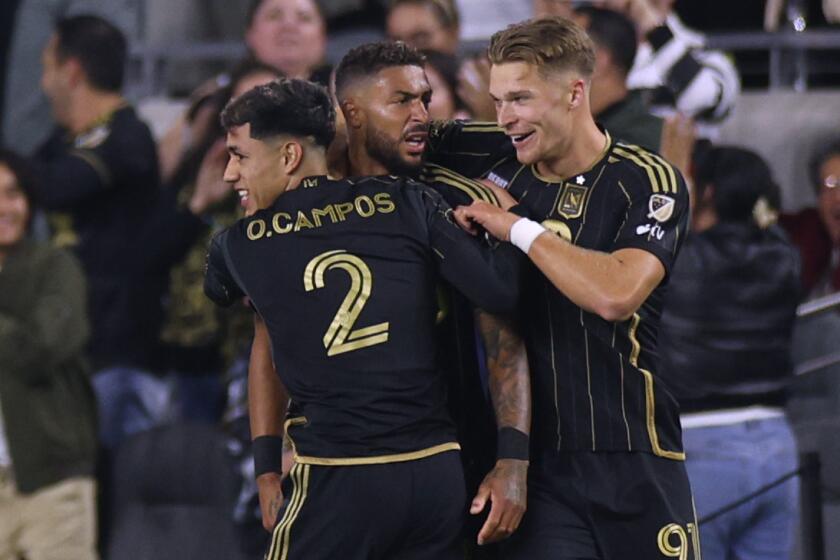Soccer! La Masia is still producing quality players
Hello and welcome to this week’s edition of the L.A. Times soccer newsletter. I’m Kevin Baxter, the Times’ soccer writer. We begin this week in Spain, where La Liga was shut out of the Champions League final for the first time in six years.
Twice since 2014 the Champions League title game featured two teams from Madrid, Atletico and Real. So it’s somewhat ironic that this year, when the final will be played in Madrid, it will match two English teams in Liverpool and Tottenham.
Last week we wrote in the L.A. Times about Barcelona’s famed youth academy La Masia and how, through a combination of factors, the talent pipeline from the academy to the first team had slowed to a trickle. When La Masia was developing players such as Gerard Pique, Sergio Busquets, Andres Iniesta and Lionel Messi, Barcelona flourished, winning the Champions League four times in 10 seasons.
In 2010, Messi, Iniesta and Xavi were finalists for the Ballon d’Or, the only time the same youth academy has produced each of the finalists for world player of the year. Two years later, Barcelona won a La Liga game using a lineup comprised wholly of La Masia products.
Fast forward to today when Sergi Roberto and Rafinha are the only academy graduates on the roster to have made their La Liga debuts this decade and appear in at least 20 league games since then.
That may be about to change. Barcelona has great expectations for teenaged midfield Riqui Puig, who spent six years in the team’s youth system before making his league debut last month. Alex Collado, who joined the academy when he was 10, also made his La Liga debut this spring as did teenaged forward Abel Ruiz and 21-year-old winger Carles Perez.
But the recent La Masia graduate who has made the biggest strides is midfielder Carles Alena, who came to the academy when he was 7, was promoted to the first-time roster last December and made 17 La Liga appearances this season.
He insists that’s proof the Barcelona system hasn’t lost its effectiveness.
“It is a club that demands a lot from you, especially when you are younger and good,” he said in Spanish. “For sure if I had not been in La Masia I could not have learned what I have.”
The magic of the La Masia system is the fact just one philosophy is taught there. And it’s the same difficult, precise and attractive ball-control style the first team uses. As a result, when youth players who have spent more than a decade in the academy, as Alena did, are promoted they have little trouble making the adjustment.
“Coaches, they say [players] come to the A team from the second [team], they’re one of them,” club president Josep Maria Bartomeu said. “They have been playing like this mentally since they are 8, 9, 10 years old. The way of organizing, the distribution in the pitch.”
Luis Suarez, who came to Barcelona five years ago after playing at Ajax and Liverpool, said he noticed the difference immediately.
“It is a mentality which makes you play a lot with the ball, spend a lot of time with your partner, not be so selfish. And that is the philosophy that you can see in the first team when they go up,” he said. “Because the players come with that chemistry of what Barcelona is; they come knowing what playing with Barcelona is.”
There are tradeoffs. About 55 soccer players live at La Masia; another 240 commute as many as two hours a day to training. For those who also are enrolled in school through La Masia, each weekday can have a mind-numbing rigidity, beginning with a 6:30 a.m. wake-up call, a 7:30 bus ride to a nearby public school, afternoon study sessions and soccer practice from 7 to 9 each night.
That leaves little time for normal childhood activities.
“In the end you miss all of them,” said Alena, who lived at the academy for two years. “But you are fighting for your dream. You have to leave things, leave your friends, for football. But it is also true that in La Masia you are with your teammates. We always help each other because the other person is experiencing the same thing.
“There is a lot of mutual help because it is clear that you miss your family and your home a lot.”
Some miss their family so much they don’t stay. Iniesta, who went on to become one of the best midfielders of the modern era, remembers “crying rivers” when left his home 300 miles south of Barcelona for La Masia at the age of 12. He said he thought more than once about quitting.
Many others have followed through on that impulse.
“We have had some players that were very talented. But they cannot live without their parents,” said Denis Silva, one of 40 coaches at the academy. “Not everybody has enough personality or talent to be in Barca.
“Everybody has pressure here. The players, the coaches, the bosses. But we don’t obligate them to be here…because it is very, very difficult. So you need to learn about pressure from the very beginning. If you don’t feel good and you think it’s too much for you, there are a million [other] clubs for you to go to.”
There are positives besides the soccer though. Alena said it became much easier to study when he came to La Masia. When he lived at home, he said his schoolwork was repeatedly interrupted by training and travel to tournaments.
At the academy, he said “the studies adapt to you. If you had a trip, you could postpone an exam. That was the great advantage. We were 8 or 9 per class. You learned much faster, the teacher explained much better. We could talk to him.
“When you go to a normal school there are 30 people in a class.”
There are two Americans at La Masia, Konrad de la Fuente, a member of the U.S. U-20 national team, and Adrian Simons. De la Fuente, 17, plays for Barcelona’s B team, is a Florida native and son of a Haitian diplomat. He has lived in Spain more than half his life. Simons, 13, moved to Barcelona from Colorado with his family last year.
De la Fuente said he’s not sure what would have happened to his soccer career if he had stayed in the U.S.
“I’m happy where I am,” he said.
As is Alena, who underwent 13 years of intense instruction at La Masia to make the first team – then found out he needed every one of those training sessions.
“I’ve been here all my life now to reach the first team. It is clear that the level is much higher and the risk much higher,” he said. “But you already have these things that you learned as a child [so] it is much faster; the head does it alone. That helps you a lot to read the game.
“You appreciate it when you get to professional football.”
The challenge now is to get others to follow him, restoring La Masia to the glory of not so long ago.
Tie doesn’t fit LAFC well
After scoring LAFC’s only goal in Sunday’s 1-1 draw with FC Dallas, Carlos Vela couldn’t decide if the result was a good one or a bad one.
“It feels like we dropped two points,” he said. “But when you’re playing on the road, sometimes one point is a good thing.”
There were other reasons to both disappointed and pleased at the same time. Vela, for example, missed one penalty kick but coveted a second, giving him a league-high 14 goals in as many games. And though LAFC couldn’t beat a team that played the final 41 minutes with just 10 men, the draw kept it five points clear of Seattle in the Supporter’s Shield race and extended its unbeaten streak to six games.
Sunday’s game marked the second time in three road games that LAFC had a man advantage for more than 40 minutes yet had to settle for a tie. Last month in Seattle the Sounders’ Cristian Roldan was sent off in the 18th minute and Kelvin Leerdam in stoppage time but the game ended 1-1.
LAFC has seen seven opponents red-carded this season.
Unlike Vela, coach Bob Bradley, found little to like in Sunday’s game and blamed the MLS schedule-makers, who forced LAFC and Dallas to play one another twice in four days with a 1,500-mile trip in between.
“It’s hard playing the same team back to back like this. The travel for both teams,” Bradley lamented. “Today was a frustrating game. You watch guys trying to make plays but no real fluidity, not real sharpness. It was choppy at the beginning, all sorts of fouls, and the referee talking to everybody after every play.
“We tried hard to get something that feels like football going but on a night like tonight it’s just impossible.”
Watch Vela’s league-leading 14th goal by clicking here.
The compressed schedule also forced Bradley into some unwanted squad rotation, holding forwards Christian Ramirez and Adama Diomande out of the starting lineup, giving midfielders Andre Horta and Lee Nguyen their first starts in two months, sitting defender Jordan Harvey for just the second time this season and leaving midfielder Eduard Atuesta home after he sprained a knee last week.
However if LAFC has slowed, playing to draws in three of its last five matches, it is still on pace to top 75 points, breaking the single-season record set last season by the New York Red Bulls. Vela remains on pace to break Josef Martinez’s single-season record of 31 goals while goalkeeper Tyler Miller, who has allowed one goal in his last four games and just nine on the season, could break the record for fewest goals conceded in a full season.
Another sign of how well LAFC is playing is the fact it was one of four MLS teams to see six players named to their national teams’ preliminary roster for next month’s Gold Cup. Miller, Ramirez and defender Walker Zimmerman made the U.S. squad; midfielder Mark-Anthony Kaye and defender Dejan Jakovic were called up by Canada; and midfielder Peter-Lee Vassell was chosen by Jamaica.
Vela declined a call-up to the Mexican team.
Bradley’s team next plays Friday, facing Montreal (6-5-3) at Banc of California Stadium where LAFC (9-1-4) has a league-long 13-game regular-season unbeaten streak dating to last summer.
Galaxy: ‘We should be doing better than this’
Meanwhile Southern California’s other team is heading in the opposite direction. Because if the Galaxy didn’t hit rock bottom in Sunday’s inexplicable 1-0 loss to the Colorado Rapids, they can certainly see the bottom from where they are.
Hyperbole? Take a look at the facts: The Rapids hadn’t won a game since last October. Then they played the Galaxy.
Colorado keeper Tim Howard had allowed more shots to get past him (30) then he had saved (29) before Sunday. And he hadn’t had a shutout this season. Then he played the Galaxy.
The Rapids hadn’t even led a game in more than a month. Then they played the Galaxy.
The Galaxy entered May one point off the league lead. They’ve lost four straight since then, haven’t scored in their last two games – both at home – and have one goal in the last 317 minutes overall. If that’s not the bottom, they’ll need shovels to go deeper.
(Watch Howard rob the Galaxy’s Uriel Atuna by clicking here.
“Really not happy with getting that result at home against that team who hasn’t won all year,” defender Dan Steres said. “It’s a disappointing feeling. Pretty frustrating as well.”
The Galaxy (7-5-1) dominated in nearly every way possible. They had 67.5% possession and completed more than twice as many passes. But they had one fewer goal.
Of course they were also without captain and scoring leader Zlatan Ibrahimovic, who watched with his family from a suite after being suspended two games for “violent conduct” in the closing minutes of the team’s loss to New York City FC. The team was also missing midfielder Romain Alessandrini, who is out until at least September after knee surgery.
Alessandrini missed two games earlier this season with a hamstring issue; The Galaxy are 5-0 with him in the lineup and 2-5-1 without him.
“When we don’t have Ibra the team can feel like something’s happened with us because he’s our forward,” coach Guillermo Barros Schelotto said. “But we need to work because we know that Ibra is not coming the next game. We need to figure it out and not count Ibra as an excuse.
“He’s very important for us, it is clear. Romain is very important. But we need to try to do something without them.”
As valuable as Ibrahimovic and Alessandrini have been, however, the Galaxy’s best player this season has been midfielder Jonathan dos Santos, who returned to the lineup Sunday after missing a game and a half with a hamstring injury. But he limped off with a sore hip shortly after Colorado (1-9-2) scored. So even if he plays Friday in Orlando, Schelotto may have to manage his minutes the rest of the season to keep him healthy.
“I am not sure what happens with athlete’s bodies,” Dos Santos said. “When you recover from something you start feeling something else. It’s like a bad cycle.
“I have to take care of myself a lot. But there’s no excuse and I always try to prepare myself 100%.”
The Galaxy did get a fine 75-minute debut performance from the newly acquired Favio Alvarez, who had a team-high five shots and put two on target in the first nine minutes. And Efrain Alvarez returned from Mexico’s U-17 team to make his first appearance since the second week of the season, playing the final 15 minutes off the bench.
That it wasn’t nearly enough though. So now the Galaxy must get well while playing three games in 10 days in three states.
“I am surprised. I think we have a good team here,” Steres said. “We should be doing better than this.”
The waiting is the hardest part
The next three weeks may be the toughest of the World Cup run-up for Jill Ellis, coach of the women’s national team. The roster has been picked, there’s just one friendly left on the schedule – next Sunday against Mexico in Harrison, N.J. – and then there’s a long stretch of nothing before the team’s tournament opener with Thailand.
“Part of our job is to make sure every day our environment has to be challenging to [the players],” Ellis said. “It has to be challenging to them mentally, it has to be challenging physically. So that they are consistently on the edge.
“What you deal with elite athletes they are always looking for that next thing to attack or conquer or climb or whatever.”
That may be especially true for the 11 first-time World Cup players on the roster. Ellis tried to manage that by calling some of them up for the 2016 Olympics, giving them the chance to experience the pressure and expectation of a major event.
Even that might not fully acclimate them though. Ellis said she was surprised by the attention the last World Cup received and this one, she predicts, will put that experience to shame.
“We already feel the buzz,” she said. “Going into [2015] I didn’t really know what to expect. And even when you’re in it, I didn’t realize how big that was until we came back to the States. But this one, just the interest, it’s off the charts.”
“They know it’s go time,” she said of her players. “We’re gearing up for a World Cup. You can just see there’s a laser focus, laser edge. Everybody is genuinely energized. But we also realize this is also a job. And it will be an amazing journey.”
And finally, a personal request
By my count, which is always suspect, this is the 36th edition of the soccer newsletter, which means we’ve done enough of these to have established a rhythm but not too many that we can’t still change course.
So what do you like and what should we change? Is it too long? Too short? Too focused on MLS? Too much on Europe? You want more opinion? Or less?
Drop me a line by clicking here and let me know.
Podcast
Don’t miss my weekly podcast on the Corner of the Galaxy site as co-host Josh Guesman and I discuss the Galaxy each Monday. You can listen to the most recent podcast by clicking here.
Until next time
Stay tuned for future newsletters. Subscribe here, and I’ll come right to your inbox. Something else you’d like to see? Email me. Or follow me on Twitter: @kbaxter11.

